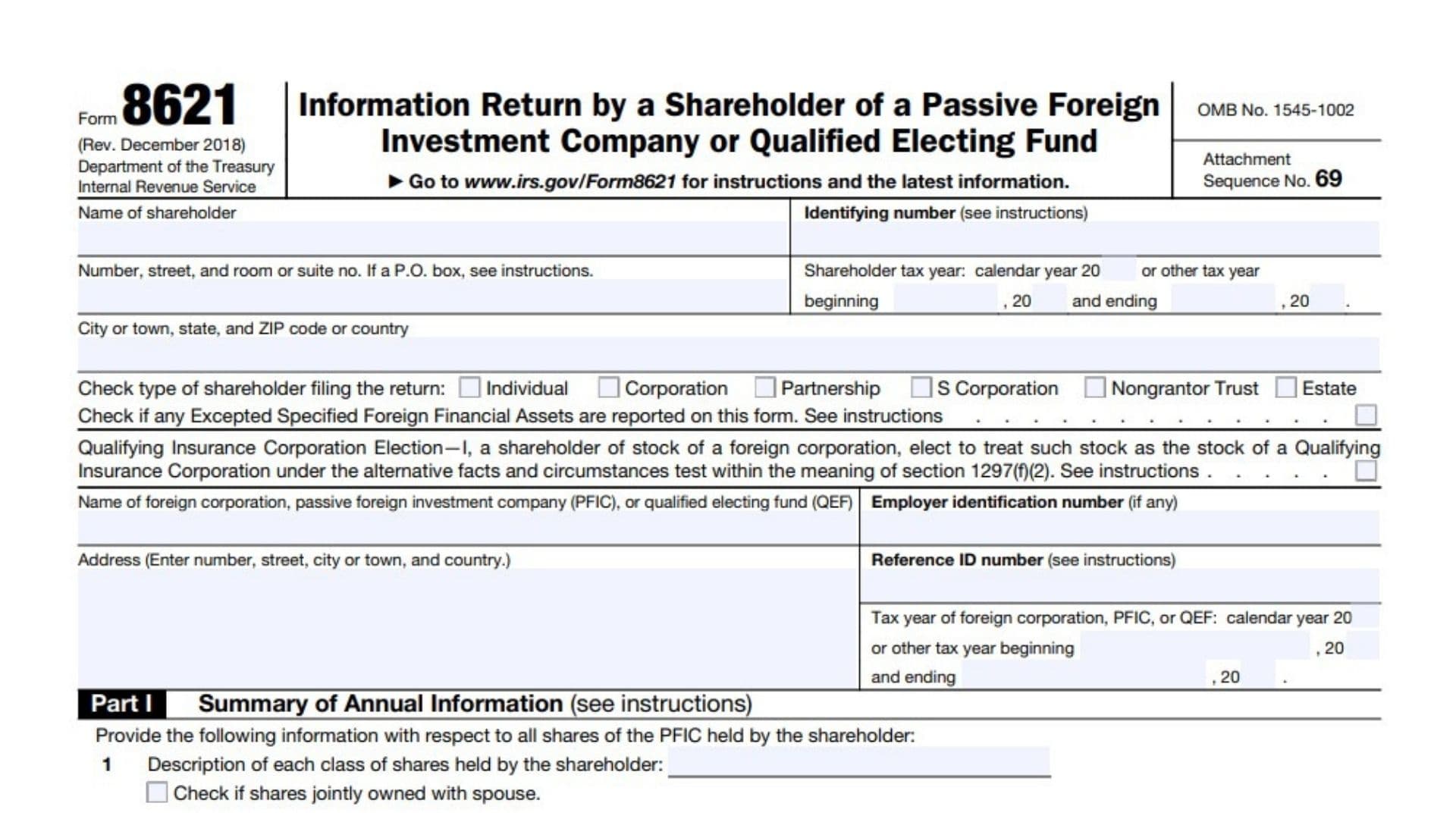IRS Form 8621, officially titled “Information Return by a Shareholder of a Passive Foreign Investment Company or Qualified Electing Fund,” is a specialized tax form required for U.S. taxpayers who are shareholders in a Passive Foreign Investment Company (PFIC) or a Qualified Electing Fund (QEF). The purpose of Form 8621 is to report income, gains, distributions, and elections related to PFICs or QEFs. PFICs are generally foreign-based corporations with primarily passive income or assets, and the U.S. tax code imposes complex rules to prevent tax deferral or avoidance through such investments. Form 8621 is crucial for disclosing your ownership, tracking distributions and gains, and making certain elections, such as the Qualified Electing Fund election, mark-to-market election, or deferral of tax payment. Failure to file Form 8621 when required can result in significant penalties and the suspension of the statute of limitations on your entire tax return. The form is detailed and must be completed for each PFIC or QEF interest held, making accuracy and careful attention to each line essential for compliance.
How to File Form 8621?
- Attach Form 8621 to your federal income tax return (e.g., Form 1040 for individuals, Form 1120 for corporations).
- File a separate Form 8621 for each PFIC or QEF in which you have an interest.
- Submit by the due date (including extensions) of your tax return.
- Keep supporting documentation for all amounts reported.

How to Complete Form 8621?
Header Section
- Name of shareholder: Enter your full legal name.
- Number, street, and room or suite no.: Provide your complete mailing address. If using a P.O. box, follow IRS instructions.
- City or town, state, and ZIP code or country: Fill in your city, state, ZIP, or foreign country.
- Identifying number: Enter your Social Security Number (SSN), Employer Identification Number (EIN), or Individual Taxpayer Identification Number (ITIN), as applicable.
- Shareholder tax year: Indicate the calendar year or specify the fiscal year (beginning and ending dates).
- Check type of shareholder filing the return: Mark the appropriate box (Individual, Corporation, Partnership, S Corporation, Nongrantor Trust, Estate).
- Check if any Excepted Specified Foreign Financial Assets are reported: If applicable, check the box.
- Qualifying Insurance Corporation Election: If making this election under section 1297(f)(2), check the box.
- Name of foreign corporation, PFIC, or QEF: Enter the full legal name.
- Address: Provide the foreign entity’s address.
- Employer identification number (if any): Enter the EIN if available.
- Reference ID number: If no EIN, enter a unique identifying number (see instructions).
- Tax year of foreign corporation, PFIC, or QEF: Indicate the calendar year or fiscal year (beginning and ending dates).
Part I – Summary of Annual Information
- Description of each class of shares held by the shareholder: Describe the class (e.g., common, preferred). Check if shares are jointly owned with a spouse.
- Date shares acquired during the tax year, if applicable: Enter the date if shares were acquired this year.
- Number of shares held at the end of the tax year: State the total number.
- Value of shares held at the end of the tax year: Check the appropriate box for value range or enter value if over $200,000.
- Type of PFIC and amount of any excess distribution or gain:
- (a) Section 1291: Enter amount.
- (b) Section 1293 (Qualified Electing Fund): Enter amount.
- (c) Section 1296 (Mark to Market): Enter amount.
Part II – Elections
For each election, check the appropriate box if you are making that election this tax year:
- A. Election To Treat the PFIC as a QEF: Complete lines 6a–7c of Part III.
- B. Election To Extend Time For Payment of Tax: Complete lines 8a–9c of Part III.
- C. Election To Mark-to-Market PFIC Stock: Complete Part IV.
- D. Deemed Sale Election: Enter gain/loss on line 15f of Part V.
- E. Deemed Dividend Election: Enter amount on line 15e of Part V; if >0, complete line 16.
- F. Election To Recognize Gain on Deemed Sale of PFIC: Enter gain on line 15f of Part V.
- G. Deemed Dividend Election With Respect to a Section 1297(e) PFIC: Enter excess distribution on line 15e, Part V; if >0, complete line 16.
- H. Deemed Dividend Election With Respect to a Former PFIC: Enter excess distribution on line 15e, Part V; if >0, complete line 16.
Part III – Income From a Qualified Electing Fund (QEF)
All QEF shareholders complete lines 6a–7c. If making Election B, also complete 8a–9c.
6a. Enter your pro rata share of the ordinary earnings of the QEF.
6b. Enter the portion of 6a included in income under section 951 or excluded under section 1293(g).
6c. Subtract 6b from 6a. Enter as ordinary income on your tax return.
7a. Enter your pro rata share of total net capital gain of the QEF.
7b. Enter the portion of 7a included in income under section 951 or excluded under section 1293(g).
7c. Subtract 7b from 7a. Enter as net long-term capital gain on Schedule D.
If making a section 1294 election (Election B):
8a. Add lines 6c and 7c.
8b. Enter cash and fair market value of property distributed/deemed distributed during the QEF’s tax year.
8c. Enter portion of 8a not already in 8b attributable to shares disposed, pledged, or transferred during the year.
8d. Add 8b and 8c.
8e. Subtract 8d from 8a (if zero or less, enter in brackets). If >0 and no portion of 6a/7a is includible under section 951, you may make Election B.
9a. Enter total tax for the tax year.
9b. Enter total tax without regard to amount on 8e.
9c. Subtract 9b from 9a. This is deferred tax, payment of which is extended by Election B.
Part IV – Gain or (Loss) From Mark-to-Market Election
10a. Enter the fair market value of your PFIC stock at year end.
10b. Enter your adjusted basis in the stock at year end.
10c. Subtract 10b from 10a. If gain, include as ordinary income. If loss, go to 11.
- Enter any unreversed inclusions (section 1296(d)).
- Enter loss from 10c, but only up to unreversed inclusions on 11. Include as ordinary loss.
If you sold/disposed of section 1296 stock:
13a. Enter fair market value on date of sale/disposition.
13b. Enter adjusted basis on date of sale/disposition.
13c. Subtract 13b from 13a. If gain, include as ordinary income. If loss, go to 14.
14a. Enter any unreversed inclusions (section 1296(d)).
14b. Enter loss from 13c, up to unreversed inclusions on 14a. Include as ordinary loss.
14c. Enter excess loss over unreversed inclusions. Report per general loss rules.
Part V – Distributions From and Dispositions of Stock of a Section 1291 Fund
Complete a separate Part V for each excess distribution/disposition.
15a. Enter total distributions from the section 1291 fund during the year for the stock.
15b. Enter total distributions (minus excess distributions not included in income) for each of the 3 preceding years (or shorter holding period).
15c. Divide 15b by 3.
15d. Multiply 15c by 125% (1.25).
15e. Subtract 15d from 15a. If >0, this is the excess distribution. If so, complete line 16.
15f. Enter gain/loss from disposition of stock. If gain, complete line 16. If loss, show in brackets and do not complete line 16.
16a. Attach a statement for each excess distribution/disposition, showing holding period and allocation of excess distribution/gain to each day in holding period.
16b. Enter total amounts from 16a allocable to current and pre-PFIC years. Enter as other income.
16c. Enter aggregate increases in tax (before credits) for each tax year in holding period (excluding current and pre-PFIC years).
16d. Foreign tax credit.
16e. Subtract 16d from 16c. Enter as “additional tax.”
16f. Determine interest on each net increase in tax from 16e using section 6621 rates. Enter aggregate interest.
Part VI – Status of Prior Year Section 1294 Elections and Termination of Section 1294 Elections
Complete a separate column for each outstanding election.
For each outstanding election:
- Tax year of outstanding election.
- Undistributed earnings to which the election relates.
- Deferred tax.
- Interest accrued on deferred tax (line 19) as of filing date.
If a section 1294 election is terminated in the current year:
- Event terminating election.
- Earnings distributed or deemed distributed during the tax year.
- Deferred tax due with this return.
- Accrued interest due with this return.
If there is a partial termination of a section 1294 election in the current year:
- Deferred tax outstanding after partial termination (subtract 23 from 19).
- Interest accrued after partial termination (subtract 24 from 20).
